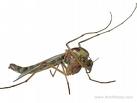 Biting midges – unlike the mosquito which have tubular sucking mouth-parts, the biting midges have well adapted cutting mouth parts for slicing through the skin of the host animal to extract blood. Midges are attracted by Carbon Dioxide (CO2) which is exhaled by all animals and humans and can be detected from 200m away.
Biting midges – unlike the mosquito which have tubular sucking mouth-parts, the biting midges have well adapted cutting mouth parts for slicing through the skin of the host animal to extract blood. Midges are attracted by Carbon Dioxide (CO2) which is exhaled by all animals and humans and can be detected from 200m away.
It is only the females who feed in this fashion, the males extract other liquids such as nectar from flowers. The females must feed on blood to ensure that the eggs they lay will survive. In doing so they inject some saliva and this causes an allergic reaction with can vary from person to person.
There are over 150 species of biting midge in the UK but the main one that causes problems is the genus Culicoides. Although minute, these flies are capable of intense irritation because of their biting habits and additionally they are known to be able to spread mammalian diseases. They tend to attack humans during overcast sultry weather and especially where the skin is sweating. They are a problem in many parts of Scotland and some coastal areas of England and Wales. Depending on the local habitat, they can also be a problem on beaches during the summer. It is the Culicoides species that is responsible for transmitting the Blue Tongue Virus in sheep and Cattle.
For your free onsite midge pest control quotation, search for your local Pestforce technician at the top right corner of this page.